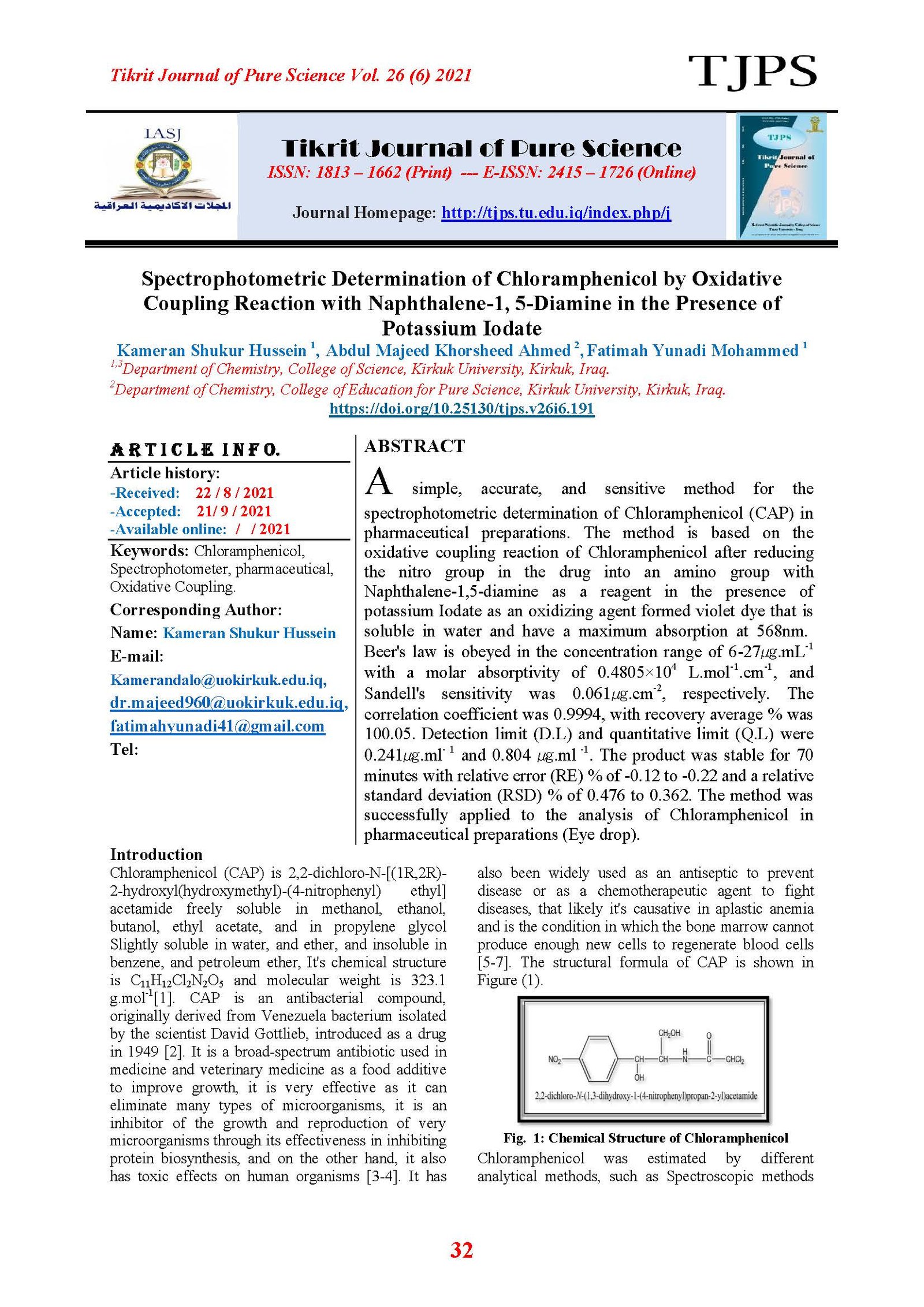Spectrophotometric Determination of Chloramphenicol by Oxidative Coupling Reaction with Naphthalene-1, 5-Diamine in the Presence of Potassium Iodate
Main Article Content
Abstract
A simple, accurate, and sensitive method for the spectrophotometric determination of Chloramphenicol (CAP) in pharmaceutical preparations. The method is based on the oxidative coupling reaction of Chloramphenicol after reducing the nitro group in the drug into an amino group with Naphthalene-1,5-diamine as a reagent in the presence of potassium Iodate as an oxidizing agent formed violet dye that is soluble in water and have a maximum absorption at 568nm. Beer's law is obeyed in the concentration range of 6-27㎍.mL-1 with a molar absorptivity of 0.4805×104 L.mol-1.cm-1, and Sandell's sensitivity was 0.061㎍.cm-2, respectively. The correlation coefficient was 0.9994, with recovery average % was 100.05. Detection limit (D.L) and quantitative limit (Q.L) were 0.241㎍.ml- 1 and 0.804 ㎍.ml -1. The product was stable for 70 minutes with relative error (RE) % of -0.12 to -0.22 and a relative standard deviation (RSD) % of 0.476 to 0.362. The method was successfully applied to the analysis of Chloramphenicol in pharmaceutical preparations (Eye drop).
Article Details

This work is licensed under a Creative Commons Attribution 4.0 International License.
Tikrit Journal of Pure Science is licensed under the Creative Commons Attribution 4.0 International License, which allows users to copy, create extracts, abstracts, and new works from the article, alter and revise the article, and make commercial use of the article (including reuse and/or resale of the article by commercial entities), provided the user gives appropriate credit (with a link to the formal publication through the relevant DOI), provides a link to the license, indicates if changes were made, and the licensor is not represented as endorsing the use made of the work. The authors hold the copyright for their published work on the Tikrit J. Pure Sci. website, while Tikrit J. Pure Sci. is responsible for appreciate citation of their work, which is released under CC-BY-4.0, enabling the unrestricted use, distribution, and reproduction of an article in any medium, provided that the original work is properly cited.
References
[1] " British pharmacopoeia on CD-Rom" The Stationery office on behalf of the Medicines and Healthcare products Regulatory Agency (MHRA). 5th .ed. London, 2007.
[2] Al-Rimawi F, Kharoaf M. (2011). Chromatography Research.
[3] Abd EI-Maboud I, Mohamed Hesham S, and Maher E. (2006). Thai. J.pharm. Sci,30, 63-81.
[4] Linling Wg, Hai Y, Chunwei Z, Yulin M, and Xiaohua L. (2008). J. Analytical Acta, 619, 54-58.
[5] Sorensen LK, Elbek T H, Hansen H. (2003). J. Assoc. Anal. Chem, 86, 703-706.
[6] Park I S, Kim N. (2006). J. Anal.Chem. Acta, 578, 19-24.
[7] Shakila RJ, Vyla S A, Kumar S, Jeyasekaran G, and Jasmine G I. (2006). Food Microbiol, 23, 47-51.
[8] Alshirifi, A. N., & Alhameedi, D. Y. (2016). New Spectrophotometric Determination of Chloramphenicol in Pharmaceutical Preparations Based on Condensation Reaction with 1, 2-Naphthoquinone-4-Sulfonic Acid (1, 2 NQS) as Reagent. International Journal of PharmTech Research, 9(9), 281-293.
[9] Wafi, A., Supriyanto, G., & Tjahjandarie, T. S. (2016). A novel spectrophotometric method for determination of chloramphenicol based on diazotization reaction at room temperature. Indonesian Journal of Chemistry, 16(1), 32-35.
[10] Jamal, S., & Othman, N. (2018). Thymol as a novel reagent in spectrophotometric determination of chloramphenicol. International J. Scientific and Eng. Res. (IJSER), 9, 862-870.
[11] A Hamoudi, T., & A Bashir, W. (2018). Spectrophotometric determination of chloramphenicol in pharmaceutical preparations. Journal of Education and Science, 27(3), 19-35.
[12] AL-Rufaie, M. M., Al-labban, H.M., & Salih, S.N. (2017). Reduction and assessment of chloramphenicol antibiotic as pure from and in various kinds of pharmaceuticals by utilizing spectrophotometric approach. Iranian Journal of Organic Chemistry, 9(2), 2087-2094.
[13] Mahmoud, T. Y., Dikran, B. S., & Mohammed, K. A. (2017). Spectrophotometric Determination of Chloramphenicol in Bulk and Pharmaceutical Preparation. Journal of Madent Alelem College, 9(2), 114-124.
[14] Śniegocki, T., Sell, B., Giergiel, M., & Posyniak, A. (2019). QuEChERS and HPLC-MS/MS Combination for the Determination of Chloramphenicol in Twenty Two Different Matrices. Molecules, 24(3), 384.
[15] AlAani, H., & Alnukkary, Y. (2016). Stability-indicating HPLC method for simultaneous determination of chloramphenicol, dexamethasone sodium phosphate and tetrahydrozoline hydrochloride in ophthalmic solution. Advanced pharmaceutical bulletin, 6(1), 137.
[16] Chu, L., Deng, J., & Kang, X. (2017). Packed-nanofiber solid phase extraction coupled with HPLC for the determination of chloramphenicol in milk. Analytical Methods, 9(46), 6499-6506.
[17] Wang, L., Yao, M., Fang, X., & Xu, Z. (2016). Highly efficient and sensitive detection of chloramphenicol based on chemiluminescence immunoassays with functionalized Fe3O4@ SiO2@ Au magnetic nanoparticles. In 2016 5th International Conference on Environment, Materials, Chemistry and Power Electronics (pp. 436-441). Atlantis Press.
[18] yu Wang, L., Yao, M., Fang, X., & Tang, P. (2016). Direct Competitive Chemiluminescence Immunoassays Based on Gold Magnetic for Ultrasensitive Detection of Chloramphenicol. International Journal of Advanced Materials and Production, 1(1), 56-61
19] Wang, L., Yao, M., Fang, X., Tang, P., & Yao, X. (2017). Gold magnetic nanoparticles-based chemiluminescence immunoassay for detection of chloramphenicol in milk. In MATEC Web of Conferenc, 88, 2-7.
[20] Meenakshi, S., Sophia, S. J., & Pandian, K. (2018). High surface graphene nanoflakes as sensitive sensing platform for simultaneous electrochemical
detection of metronidazole and chloramphenicol. Materials Science and Engineering: C, 90, 407-419.
[21] Wang, G., Mamat, X., Li, Y., Hu, X., Wang, P., Xin, X., & Hu, G. (2020). Highly sensitive electrochemical sensor for the detection of chloramphenicol based on biomass derived porous carbon. Science of Advanced Materials, 12(3), 376-382.
[22] Giribabu, K., Jang, S. C., Haldorai, Y., Rethinasabapathy, M., Oh, S. Y., Rengaraj, A., & Huh, Y. S. (2017). Electrochemical determination of chloramphenicol using a glassy carbon electrode modified with dendrite-like Fe 3 O 4 nanoparticles. Carbon letters, 23, 38-47.
[23] Abdulaziz, S. M., Bakir, H.M., Shareef, N. A. (2019). Spectrophotometric Determination of promethazine Hydrochloride in Pharmaceutical Formulation by oxidative Coupling. Kirkuk University Journal / Scientific Studies(KUJSS), 14(2), 98-124.
